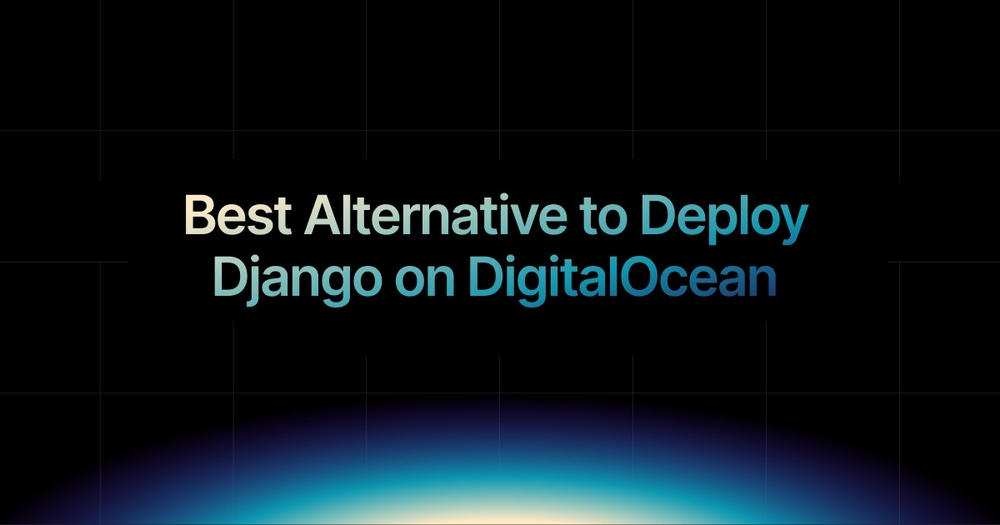Published
- 11 min read
Best Alternative to Deploy Django Apps on DigitalOcean

If you’ve ever deployed a Django app on DigitalOcean, you know it’s not exactly plug-and-play.
Yes, it’s affordable and gives you full control, but the setup can be a lot. Configuring the server, setting up Gunicorn, wiring Nginx, managing Postgres, handling static files, and ensuring everything runs smoothly after reboot.
It works, but it’s manual.
And for most projects, that’s time you’d rather spend building features, not fighting servers.
That’s why many developers eventually ask: Is there a simpler way to deploy Django without giving up performance or flexibility?
In this guide, we’ll look at what makes Django deployment on DigitalOcean challenging and introduce a much easier alternative that handles the setup for you, so you can just push your code and go.
Common Challenges When Deploying A Django App on DigitalOcean
 Deploying a Django app on DigitalOcean sounds simple, until you actually try it.
Deploying a Django app on DigitalOcean sounds simple, until you actually try it.
You start with a blank server (called a Droplet), and from there, everything is on you. Installing Python, setting up your virtual environment, configuring Gunicorn, connecting Nginx, setting up a firewall, managing your Postgres database, and keeping it all running.
You’ll need to:
- Write and maintain deployment scripts
- Manually update packages and restart services
- Troubleshoot downtime or broken config changes
- Secure your server from scratch (SSL, ports, users)
And that’s just for one app.
If you’re working on multiple projects or deploying for clients, managing all of this across different Droplets can quickly become frustrating.
This is exactly why developers start exploring DigitalOcean alternatives that offer Django hosting with built-in deployment tools, CI/CD pipelines, autoscaling, and fewer things to manage.
There are many DigitalOcean competitors out there, but not all of them are built with Django or developers like you in mind.
The good news? You don’t have to compromise between control and simplicity anymore.
Kuberns: A Smart AI-Powered Deployment Platform

Kuberns is a modern cloud platform built for developers who want to deploy and scale apps without dealing with infrastructure.
It removes the need to set up servers, configure tools, or manage deployment pipelines.
Everything is already built in, from app builds and environments to scaling, monitoring, and logs.
You don’t have to write custom scripts or worry about system setup. Kuberns is designed to save you time, reduce errors, and let you focus on building your Django app instead of maintaining it.
It works well for solo developers, growing teams, and even agencies managing multiple client projects. Whether you’re shipping an MVP or running a production SaaS, Kuberns helps you deploy with confidence and without the hassle.
If you’re looking for a DigitalOcean alternative that saves you time and effort, Kuberns is built for that.
Check out how you can deploy your Django App in less than 5 minutes
How Kuberns Simplifies Django Deployment
 Deploying Django usually means setting up a whole server from scratch every time. But that’s often the case with traditional platforms. You’re writing Dockerfiles, setting up build processes, configuring databases, handling static files, and worrying about what breaks in production.
Deploying Django usually means setting up a whole server from scratch every time. But that’s often the case with traditional platforms. You’re writing Dockerfiles, setting up build processes, configuring databases, handling static files, and worrying about what breaks in production.
With Kuberns, you skip all of that.
Once you connect your GitHub repo, Kuberns AI handles the full deployment flow automatically.
It automatically detects your Django project, builds it and gets it running without needing you to configure anything manually.
No Docker setup. No YAML files. No complicated CI/CD pipelines.
You can also:
- Add environment variables and secrets with a few clicks
- Choose your database (like Postgres) from the built-in options
- Run background workers and cron jobs if your app needs them
- Monitor builds, logs, and deployments from a simple UI
Most platforms give you a toolbox and leave the rest to you. Kuberns gives you the whole setup, already connected and ready to go.
Whether you’re updating your app or launching it for the first time, the whole process takes just a few clicks.
Performance & Scalability: Kuberns vs DigitalOcean
When you deploy on DigitalOcean, performance depends on how well you’ve set things up. You manage the server, install everything yourself, and if your app gets more traffic, you need to scale it manually.
That means resizing the Droplet, tuning configs, and hoping it doesn’t crash under load.
With Kuberns, you don’t have to worry about any of that.
Apps run on fast, optimised AWS infrastructure that scales automatically as traffic grows. There’s no downtime when you deploy updates, and you get built-in monitoring, alerts, and logs to keep an eye on performance without needing third-party tools.
You don’t need to set up load balancers or worry about server health, Kuberns handles that for you.
You get built-in features that help your app stay reliable:
- Zero-downtime deployments
- Real-time logs and alerts
- Multiple environments for safe testing
- Isolated app instances for better stability
If you’re building something that needs to grow, whether it’s a side project, a client app, or a production SaaS, Kuberns gives you the speed and scale you need, without the maintenance overhead that comes with DigitalOcean.
Cost-Efficiency: What You Get with Kuberns
 One reason many developers choose DigitalOcean is the pricing. A $5 Droplet feels affordable until you start adding everything else you need.
One reason many developers choose DigitalOcean is the pricing. A $5 Droplet feels affordable until you start adding everything else you need.
To run a Django app properly, you’ll likely need:
- A separate Postgres database
- Object storage for media files
- Load balancers or monitoring tools
- Backup systems or staging environments
These extras add up fast. What starts as a $5/month setup can easily cost two or three times more, and you still have to manage it all yourself.
With Kuberns, everything is included in one.
You get hosting, automatic deploys, Postgres, logs, multiple environments, background jobs, Monitoring and more without needing to piece things together.
Also, you don’t pay extra for each feature.
And because Kuberns runs on secure AWS infrastructure, it’s optimised to use less and save more. On average, teams save up to 40% compared to regular AWS bills, and you don’t have to manage any of it.
You know what you’re paying for, and there are no surprises.
It’s a simpler setup, and it costs less than managing things manually on DigitalOcean.
Migrating from DigitalOcean to Kuberns is Easy
 Moving your Django app from DigitalOcean to Kuberns doesn’t require a big setup or a full rewrite.
Moving your Django app from DigitalOcean to Kuberns doesn’t require a big setup or a full rewrite.
If your code is already in GitHub, you’re halfway there. Just link your repo to Kuberns, choose your environment, and deploy.
Kuberns will detect your Django app, build it, and get it running without needing Dockerfiles or manual scripts.
Need to bring your database? You can either import your existing Postgres data or connect to an external database if you prefer. Kuberns gives you both options.
The migration guide here walks you through each step from exporting your data to deploying your app. Most projects can be moved over in less than 30 minutes.
Ready to Try a Simpler Way to Deploy Django Apps?
If you’re tired of setting up servers, managing configurations, and fixing things that break during deploys, Kuberns makes it easier.
You can deploy your Django app in minutes, skip the DevOps work, and focus on your code.
No YAML, no Dockerfiles, no platform fees.

Frequently Asked Questions
1. Is Kuberns a good alternative to DigitalOcean for Django apps?
A: Yes. Kuberns is a simpler, faster alternative to DigitalOcean for Django deployment. It handles everything for you from app builds to scaling, so you don’t need to manage servers or write configuration files.
2. Can I deploy a Django app on Kuberns without using Docker?
A: Absolutely. Kuberns automatically detects your Django project and builds it for you. There’s no need to write a Dockerfile or set up any CI/CD scripts manually.
3. How does Kuberns compare to other DigitalOcean competitors?
A: While other DigitalOcean competitors offer basic hosting, Kuberns gives you a full deployment experience including CI/CD, Postgres, cron jobs, logs, and autoscaling. All built in and optimised for Django.
4. Does Kuberns support background workers and scheduled tasks for Django?
A: Yes. Kuberns supports Django background workers (like Celery) and cron jobs natively. You can set them up easily from the dashboard.
5. How long does it take to migrate a Django app from DigitalOcean to Kuberns?
A: Most Django projects can be migrated in under 30 minutes. You connect your GitHub repo, import your database, and deploy. A full migration guide is available on Kuberns Docs.
6. Will I need to manage any infrastructure on Kuberns?
A: No. Kuberns manages the infrastructure for you. You don’t need to worry about servers, scaling, SSL, or monitoring. It’s all included.
7. Can Kuberns help reduce my hosting costs compared to DigitalOcean?
A: Yes. Since Kuberns runs on optimised AWS infrastructure, many users save up to 40% compared to managing similar setups on DigitalOcean or AWS directly.